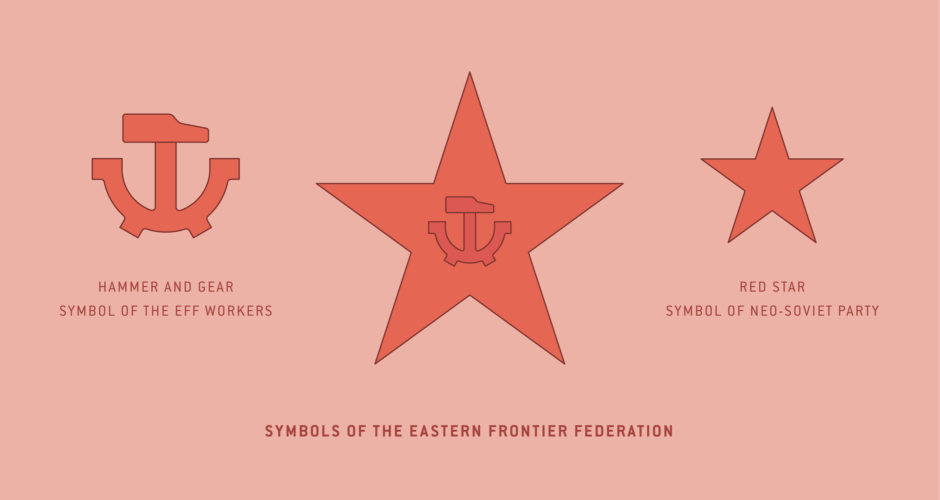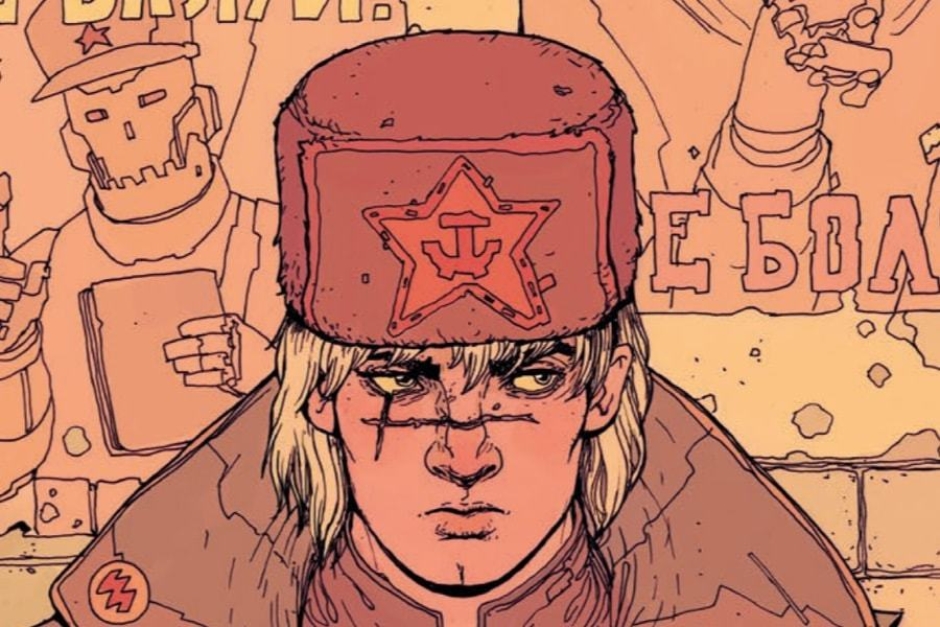
Eastern Frontier Federation
Government, Nation
Year 2107
The Eastern Frontier Federation (EFF) is a heavily industrialized nation run by the Neo-Soviet Party, with its capital in the city of L3n1ngrad. Its abundant resources and industry caught the attention of the Robotic Union, which led to a trade agreement and robot migration to the EFF.
Overview: The EFF Identity

Intro: The EFF and the Neo-Soviets
The Eastern Frontier Federation (EFF) is a far future twist on the Soviet Union, that consists of the region’s cities, mines and oil rigs that survived the Multi-Wars. Being a heavily industrialized nation, the EFF maintains a trade agreement with the Robotic Union, which purchases raw materials from the Federation.
The Federation is run by a single political group known as the Neo-Soviet Party, with the Supreme Soviet as its leader and Comrade Robo-L3n1n serving as a puppet leader for the robot population. The Central Committee administers and governs the mega-city capital of L3n1ngrad, with law and order maintained by the Militsiya police force. It is a government known for its brutal and oppressive treatment of political dissidents and free thinkers, which are sent to work camps as punishment.
Much thanks to Josan Gonzalez, aka Deathburger, for answering my questions and sharing the inspiration behind the symbols and logos he created for The Future is Now 2.

Figure 1.1 The mega-city of L3n1ngrad — capital of the EFF.
Symbol Usage

Figure 2.1 The hammer and gear symbol, along with the red star, are heavily applied throughout the city scenes of L3n1ngrad.

Figure 2.2 Both symbols can be found on Neo-Soviet propaganda posters and billboards throughout the city.

Figure 2.3 An example of the hammer and gear symbol, within a red star, as worn on the cap of a Neo-Soviet police officer.

Figure 2.4 Working class robots are seen wearing the symbols on armbands, caps and work aprons.

Figure 2.5 The Neo-Soviet police force, known as the Militsiya, wear helmets and body armor bearing the symbols.

Figure 2.6 When Sai navigates the sewers of L3n1ngrad, to free an imprisoned robot, we see the hammer and gear on a large boilerplate.
Design Analysis
As noted in the intro, both the EFF and the Neo-Soviet Party have parallels in the real-world, with identities that have inspired the symbols we see in The Future is Now 2.
The hammer and gear is inspired by the hammer and sickle, which is a symbol of communism and socialism (Figure 3.1). This real-world political symbol is meant to represent proletarian solidarity — the union of peasantry and working-class — and it was first used during the Russian Revolution, where the hammer represented the urban industrial workers and the sickle represented the rural peasants. Both it and a red star would go on to be used on the communist flag, which represented the Union of Soviet Socialist Republics (USSR) from 1922 to 1991, and the communist movement as a whole.
The hammer and gear mark we find the Neo-Soviets using in 2107, carries similar meaning — a hammer still represents the worker, but one half of a machine gear takes the place of the sickle, which Josan described as representing machines and production. It goes without explanation, but one can assume that rural agriculture became less relevant after the Multi-Wars poisoned a majority of the land with radioactive fallout, and food production moved into urban factories and labs. The increased importance of heavy industry and robotics easily explains the gear, which the hammer is nested in. The arrangement of the two symbols implies that the worker is standing on the strength of their nation’s industry and production. And this Neo-Soviet symbol doesn’t feel out of place, in the context of other real-world Soviet symbols, where gears are common occurrences in a variety of configurations with other elements (Figure 3.2).
The red star, that we see just about everywhere we look in the EFF, is also a communist symbol in reality. In the communist flag it resided above the hammer and sickle, representing the Communist Party of the Soviet Union. Interestingly, the real-world use of a red star by the communist movement has some roots in science fiction as well, where it was the title of Alexander Bogdanov's 1908 science fiction novel, Red Star, about a communist society on Mars.
While the symbols are predominantly used as standalone elements, there is at least one instance where we find the hammer and gear nested within the red star, prominently displayed on the cap of a figure we see throughout the story as it takes place in L3n1ngrad — likely an agent of the Neo-Soviet Militsiya or secret police. This nesting of symbols was also something we could find in the real-world, for official symbols and badges of Soviet government (Figure 3.3).
And just as we’ve found with other nations and factions within the world of The Future is Now 2, we see armbands militantly bearing the symbols of the Neo-Soviets, being worn by many characters. In the EFF this is particularly important, as there is only one political party and allegiance to any other gets you tossed in a gulag.
Another prominent usage is the application of the symbols to Neo-Soviet propaganda (Figure 2.2). Many of the posters we see in the EFF are inspired by real-world poster art from communist Russia and China, remixed with Neo-Soviet branding (Figure 3.4).
Taken as a whole, the EFF is a nation completely saturated with the symbols of its monolithic identity, which stands in contrast to what we find in the Robotic Union, where the state’s symbols compete with those of corporations and various factions within the citizenry. But it’s not too different from what became of the Independent Northern States under The Network, where the media and government have become a homogenous entity. What becomes apparent as we explore the world Josan has created in The Future is Now 2, is that where the power lies in a given nation and the degree of oppression those powers exert, can almost be gauged by measuring the presence of a visual identity in the art. It's definitely a clever approach when crafting a visual narrative of this nature, that the audience is navigating and decoding without the aid of text.

Figure 3.1 The hammer and gear symbol (left) is inspired by the hammer and sickle (right), which is a symbol of communism and socialism.

Figure 3.2 The gear as an element in Soviet logos and symbols is not without real-world precedents. Source: Symbolism Catalog Directory, 1986

Figure 3.3 Soviet era official badges, like that of the KGB (bottom-left) use a hammer and sickle nested within a red star. Source: Wikipedia

Figure 3.4 Neo-Soviet propaganda posters are remixes of real-world communist posters from Russia and China.

Cover image for The Future is Now 2 - Neon Rising
THE DESIGNER: JOSAN GONZALEZ
AKA DeathBurger
Illustrator, Architect and Grand Maker of Pizza. Head Archivist of The Ministry of Information of Robo-City Prime, Robotic Union. Designated by The Machine to manage the New Citadel 9, an independent publishing house that releases all The Future is Now related books, prints, original art and merchandise.
Rituals performed at:
Dynamite Entertainment, Boom! Studios, Dark Horse, Games Magazine, Agat and Cie Films, Medium Corp, Editora Aleph, Wired Magazine, Avex Music Group, Paramount Pictures, RoadSec, Harmonix Systems, Metallica, Mondo, Pearl Jam, CDProjekt Red.
Ocassionally summoned at:
3D Total's Sketching from Imagination: Sci-Fi, ImagineFX (FX Posé, March 2016)
To learn more, visit: